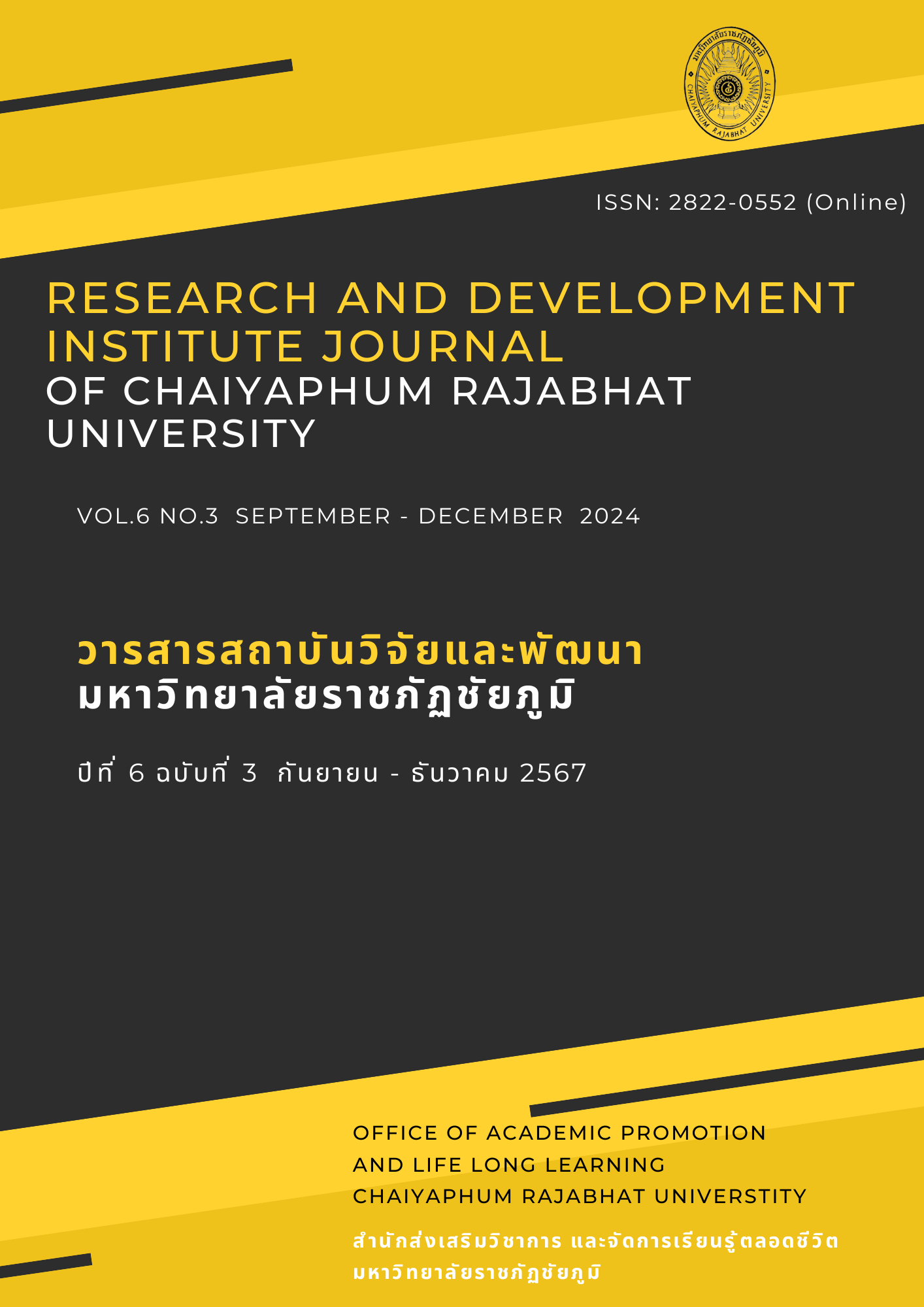USING SCAFFOLDING TECHNIQUE TO SOLVE READING ALOUD AND SPELLING PROBLEMS OF PRIMARY SCHOOL STUDENTS
Main Article Content
Abstract
This research aimed to 1) develop the learning management plan using the scaffolding technique for primary school students to be effective according to the 70/70 criteria, 2) compare the reading aloud skills of primary school students before and after learning by using the scaffolding technique, and 3) examine the development of the reading aloud skills of primary school students using the scaffolding technique, 4) compare the spelling skills of primary school students before and after learning by using the scaffolding technique, and
5) examine the development of spelling skills of primary school students using the scaffolding technique. The target groups were 4 primary school students who were not successful in learning Thai language, and had reading aloud and spelling problems, studying in Grade 4 in the first semester of the academic year 2024 at Ban Nang Daet Nuea School, under Chaiyaphum Primary Educational Service Area Office 1. They were selected by a purposive sampling method. The research instruments included 1) 15 lesson plans for solving reading aloud and spelling problems of primary school students using the scaffolding technique; 2) a 20-question test for assessing reading aloud skills of primary school students; and 3) a 20-question test for assessing spelling skills of primary school students. The statistics used for analysis were mean, standard deviation, and percentage.
The research finding can be presented below.
1) The efficiency values of the learning management plan using scaffolding technique for primary school students were 70.25/71.25.
2) The reading aloud skills of Grade 4 students using the scaffolding technique were higher than before studying.
3) The students who studied by using the scaffolding technique showed a progressively higher development in reading aloud at a good level.
4) The spelling skills of Grade 4 students using the scaffolding technique were higher than before studying.
5) The students who studied by using the scaffolding technique showed a progressively higher development in spelling at a good level.
Article Details

This work is licensed under a Creative Commons Attribution-NonCommercial-NoDerivatives 4.0 International License.
Permission to use text, content, images, etc. of publication. Any user to read, download, copy, distribute, print, search, or link to the full texts of articles, crawl them for indexing, pass them as data to software, or use them for any other lawful purpose. But do not use it for commercial use or with the intent to benefit any business. Published under a Creative Commons Attribution-NonCommercial-NoDerivatives 4.0 International License.

This work is licensed under a Creative Commons Attribution-NonCommercial-NoDerivatives 4.0 International License
References
กระทรวงศึกษาธิการ. (2551). หลักสูตรแกนกลางการศึกษาขั้นพื้นฐาน พุทธศักราช 2551. โรงพิมพ์ชุมนุมสหกรณ์การเกษตรแห่งประเทศไทย.
กานต์รวี ศรีลางค์. (2556). ความสามารถด้านการอ่านภาษาอังกฤษเพื่อความเข้าใจของนักเรียนชั้นมัธยมศึกษาปีที่ 5 ที่ได้รับการสอนด้วยยุทธศาสตร์การเสริมต่อการเรียนรู้ประสบการณ์การอ่าน. [วิทยานิพนธ์ปริญญาศึกษาศาสตรมหาบัณฑิต]. มหาวิทยาลัยขอนแก่น.
ณภัชนันท์ บุญระมี. (2563). การใช้กลวิธีการอ่านแบบเสริมต่อการเรียนรู้ร่วมกับกิจกรรมการเรียนรู้ที่เน้นสมองเป็นฐานเพื่อพัฒนาความสามารถด้านการอ่านภาษาอังกฤษของนักเรียนระดับชั้นมัธยมศึกษาปีที่ 5. [วิทยานิพนธ์ปริญญาการศึกษามหาบัณฑิต]. มหาวิทยาลัยมหาสารคาม.
บุญชม ศรีสะอาด. (2556). การวิจัยเบื้องต้น (พิมพ์ครั้งที่ 9). โรงพิมพ์สุวีริยาสาส์น.
พริมรตา จารุกิตต์กุล. (2566). การพัฒนาความสามารถด้านการอ่านและเขียนสะกดคำ ของนักเรียนชั้นประถมศึกษาปีที่ 1 โดยใช้วิธีการให้นั่งร้าน (Scaffolding) ด้วยแบบฝึกทักษะ. [วิทยานิพนธ์ปริญญาครุศาสตรมหาบัณฑิต]. มหาวิทยาลัยราชภัฏชัยภูมิ.
พิมลพร พงษ์ประเสริฐ. (2563). การพัฒนาผลสัมฤทธิ์ทางการอ่านและการเขียนสะกดคำของนักเรียนชั้นประถมศึกษาปีที่ 1 โดยการจัดการเรียนตามรูปแบบของฮันเตอร์ร่วมกับแบบฝึกทักษะ. [วิทยานิพนธ์ปริญญาศึกษาศาสตรมหาบัณฑิต]. มหาวิทยาลัยศิลปากร.
สุชนินธ์ บัณฑุนันทกุล และวรวรรณ เหมชะญาติ. (2558). การพัฒนากระบวนการสอนซ่อมเสริมตามแนวประสบการณ์การอ่านแบบเสริมต่อการเรียนรู้ที่มีต่อความสามารถในการอ่านเพื่อความเข้าใจของนักเรียนประถมศึกษาปีที่1. วารสารวิชาการศึกษาศาสตร์ คณะศึกษาศาสตร์ มหาวิทยาลัยศรีนครินทรวิโรฒ, 17(2), 70-82.
สมนึก ภัททิยธนี. (2551). การวัดผลการศึกษา (พิมพ์ครั้งที่ 6). ประสานการพิมพ์.
สำนักงานเขตพื้นที่การศึกษาประถมศึกษาชัยภูมิ เขต 1. (2566). รายงานการคัดกรองความสามารถการอ่านการเขียนนักเรียนระดับชั้นประถมศึกษา ปีการศึกษา 2566. กลุ่มนิเทศก์ติดตามและประเมินผลการจัดการศึกษา สำนักงานเขตพื้นที่การศึกษาประถมศึกษา.
Hartman, H. (2002). "Scaffolding & Cooperative Learning" Human Learning and Instruction. City College of City University of New York.
Larkin, M. J. (2001). Providing Support for Student Independence through Scaffolded Instruction. Teaching Exceptional Children, 34(1), 30-34. https://doi.org/10.1177/004005990103400104
Rosenshine, B., & Guenther, J. (1992). The Use of Scaffolds for Teaching Higher Level Cognitive Strategies. In J.W. Keefe, & H.J. Walberg, (Eds.), Teaching for teaching. (pp. 35-38), Verginia: National Association of Secondary School Principle.
Van de Pol, J., Volman, M., & Beishuizen, J. (2010). Scaffolding in Teacher-Student Interaction: A Decade of Research. Educational Psychology Review, 22(3): 271-296. https://doi.org/10.1007/s10648-010-9127-6
Wood, D., Bruner, J. S., & Ross, G. (1976). The role of tutoring in problem solving. Child Psychology & Psychiatry & Allied Disciplines, 17(2), 89-100.


